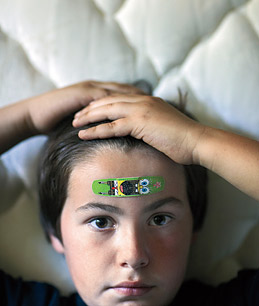
(3 of 4)
Things get trickier when the condition in question is bipolar disorder, usually characterized by a cycling between hyperkinetic highs and deep, depressive lows. As recently as seven or eight years ago, the accepted wisdom was that parents did not have to worry about kids being bipolar because it doesn't strike until later in life. That position changed as doctors began acknowledging that some kids have symptoms that can't be explained any other way. "In psychiatry, if you don't ask the questions, you're not going to get the diagnosis," says Axelson. "A lot of things that were labeled as conduct problems may be bipolar."
But once doctors and parents began looking for bipolar disorder, they started finding it everywhere — even when it wasn't there. In 2002 researchers reported that within a single generation, the average age of onset of the disorder had fallen from the early 30s to the late teens. Few conditions change their nature so suddenly, and many of those bipolar cases were surely misdiagnoses. Today, says Axelson, the thinking is that about 1% of kids in the 15-to-17 age group suffer from true bipolar disorder, about the same prevalence as in adults.
Parents concerned that their child may be exhibiting bipolar symptoms can probably stop worrying if all they notice is that the child is sometimes very gloomy and sometimes exceedingly active. For one thing, the same can be said of all human beings. What's more, the symptoms of ADHD resemble the symptoms of bipolar disorder's manic stage. That's not to say that ADHD isn't its own kind of problem, but it's a less severe one than bipolar. The key to distinguishing between the two, Axelson explains, may be "episodicity," or a clear cycling of moods, with hyperactive symptoms largely disappearing during low periods. Ultimately, as with all psychological conditions, it takes a professional — sometimes two — to provide a good diagnosis. In the case of bipolar disorder, with so many moving parts and symptoms, this is particularly true.
The Best Medicine
Treatment for childhood emotional ills are as varied as the conditions themselves, and many can be administered with a very light touch. Anxiety conditions, including phobias and OCD, respond well to a technique known as exposure and response prevention. Kids are exposed to graduated levels of the thing they fear while a therapist or parent remains nearby to help them habituate to the anxiety and resist the impulse to flee.
In the case of a child with a phobia of dogs, for instance, treatment might involve first looking at a drawing of a dog, then a photograph, then a video. Finally, the child might be encouraged to look at a dog from inside a closed car and to eventually approach one. "The pace of the exposure," says Wegner, "depends on the temperament of the child."
Bethany overcame her obsessive-compulsive anxiety about her sexuality by first looking at pictures of sexy actresses and trying to notice feelings of actual arousal. If she thought she felt something (and after years of self-scrutiny, that was all but certain), she tried to accept — and shrug at — the questions it raised. Next she began going to movies about lesbian couples, like The Kids Are All Right, and reading magazine stories about women who discovered their homosexuality later in life — accepting the possibility that their story could be hers.
The same kinds of exercises would not have been appropriate if Bethany had begun treatment in childhood. But other steps, such as talking openly about homosexuality, getting to know gay couples or even, say, looking at pictures of the celebrity wedding of Ellen DeGeneres and Portia de Rossi, could have the same effect. With all forms of OCD, this kind of therapy has a habituating and disarming effect. Spend a lifetime running from trigger situations, and they'll always have power over you. Seek them out and learn to tolerate them and you're back in charge.
Clinical depression can be a bit more of a challenge. It usually does not emerge until the early teen years and may involve not just gloom but also anxiety. For both kids and adults, cognitive therapy can be an effective treatment. Rather than spending years peeling back the onion skin of the psyche, cognitive therapists help patients reframe problems so they're seen not as disasters worthy of a bout of depression but challenges that can be overcome. For kids, therapy need not be structured as weekly meetings in a doctor's office — at least not at first. Intervention by parents and teachers who help children resist catastrophizing and get them to surf through setbacks may be a good start.
When formal therapy for any condition does seem called for, more and more professionals agree that it's best if the family gets involved. The Journal of the American Academy for Child and Adolescent Psychology now makes a point of listing practice parameters not just for diagnosing and treating kids but also for evaluating the entire household. "Those two things are absolutely critical for young children," says Wegner, "because more so than adults, children exist principally in the context in which they're being raised."